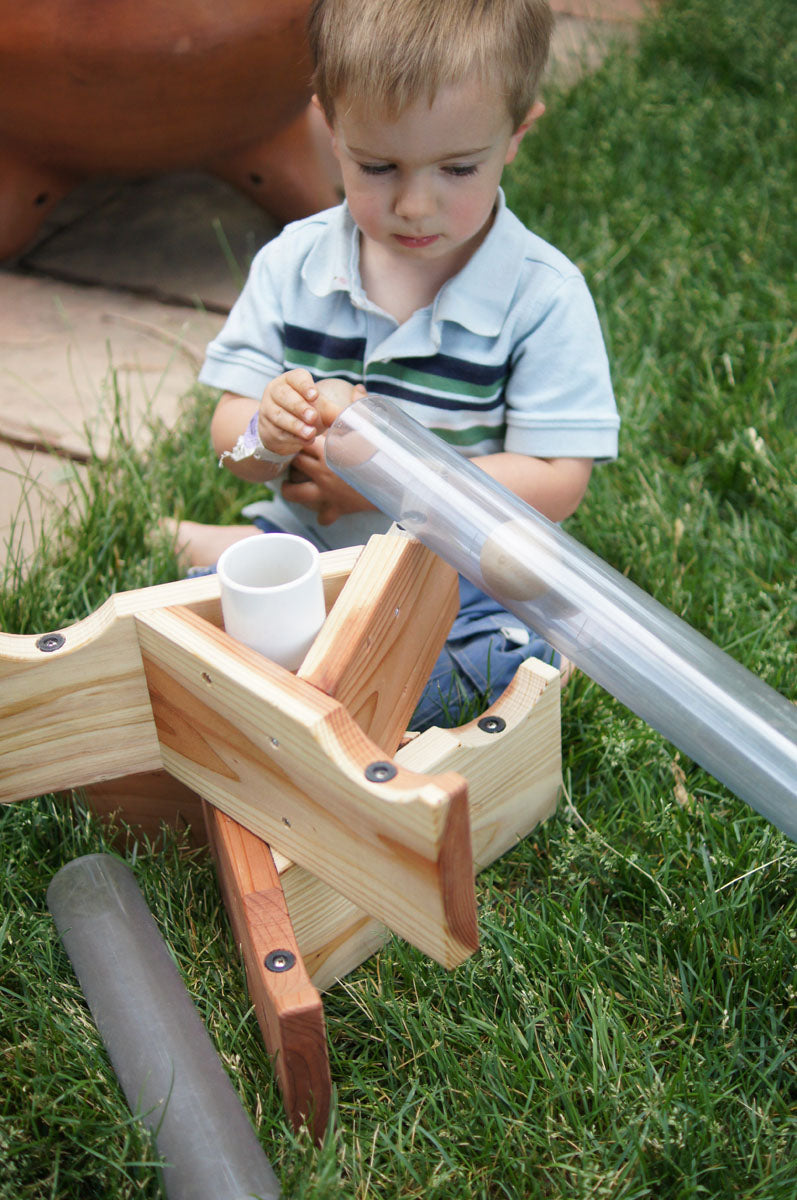There’s something appealing about watching water trickle down a stream bed or rocks tumble down a hillside. This action is often replicated in the classroom. At Kodo, our designers pay a great deal of attention to the ways in which materials move and are transformed in the natural and man made world. Children are fascinated by things in motion, watching balls zoom down a ramp, water spill from a gutter and train cars bounce over a bumpy track.
The
See-Inside Tubes were created as an open-ended accessory for the classroom, with motion, momentum and visibility in mind. Small cars and balls can easily pass through them, allowing children a unique means for watching materials in motion. They’re a natural companion to blocks, builders and ramps. They can be used with dry or wet materials and can easily be moved from indoors to out. Children naturally use them as play props; voice amplifiers, spy scopes, flag poles, mail shoots, train tunnels and pathways.When we think of ramps we usually think about long, open-topped tracks of some sort. Tubes also function as ramps. If you’ve ever been propelled down a theme park water slide, you know what we mean! If you have PVC pipes and connectors in your block/construction play area, consider setting up at least one ramp, tube and elbow joint combination. ( Most 2” pvc fittings will work. ) In this way you’ve hinted to one possible use and can step back to observe the other ways children will combine materials.
With block construction, we’ve seen children use the See-Inside Tube as “crystal towers” for castles, telescopes for pirate ships and as “underground” water pipes for their block cities and gardens. We heard from one teacher, that after visiting a local park, her children used the tube, a garden hose, and some bricks to build their own representation of the fountain they found on their outing.
Clear water, tinted water, and bubbly water are all made more exciting with the addition of the See-Inside Tubes in the water, sensory table or mud kitchen. We’ve found that children are especially fond of filling them with sensory materials like seeds and beans and often use the tubes much like graduated cylinders while employing unconventional ways of measuring volume.
In the outdoor construction play space, we’ve seen the See-Inside Tubes used as water flume components, as a way of watching sloshy sand move back and forth and incorporated into a long system of pipes used to carry water to potted plants. Many types of flexible hose (available at hardware stores) work well as construction materials when combined with these tubes.
Children naturally use the see inside tubes on the light table or light box. Offer colorful tissue paper, scarves or mylar so that children can fill them and combine them with light. What happens in a darkened space when flashlights are placed on the ends to illuminate materials inside?If you have infants and toddlers in your center, these tubes will delight them as they scoot, reach and chase after tubes sent rolling across the floor or down a gentle slope. Fill them with items that produce sound, (bells, pebbles, etc), for added interest.
One of our friends, a teacher, left a small length of tube in her school garden overnight. The next morning she and the children were delighted to find some insects inside. The children were able to see these particular beetles walking about, climbing over one another and walking “upside down”. After some time of observation and sketching the shapes of insect bodies they left the tube in the garden so the beetles could “go home”. The teacher was so pleased to see how respectful her children were to these small creatures and commented on how well the tube worked as a window for viewing the tiny world of beetles.
Some vocabulary you might incorporate while using the tubes: motion, momentum, opaque, cylinder, column, connection, ramp, tunnel, pathway, force.
Some questionsyou might propose: What fits inside? What doesn’t? Sort them. Can we devise a way to measure those things? How does raising one end of a tube or ramp effect speed and distance? What causes a ball to travel slowly or quickly? Does the bell sound as loud inside the tube as outside? Why can some insects walk “upside down”? What would people need to do that? Where are tunnels and pipes used in the world? Can an object travel an upward path? How can this be? What does force or energy have to do with it? Where should we keep our pipes so we can take turns using them? No matter how your children use the See-Inside Tubes, we’re sure you’ll find inventiveness and creativity at the core of their explorations.


Share:
STEM Engineering - Building with Sand Bags
Every Picture Tells a Story - Natural Play